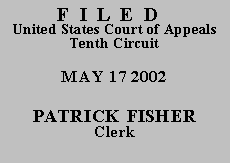 PUBLISH
PUBLISH
 PUBLISH
PUBLISH
UNITED STATES COURT OF APPEALS
TENTH CIRCUIT
| UNITED STATES OF AMERICA,
Plaintiff-Appellee, Defendant-Appellant, |
No. 01-4179 |
Appeal from the United States District Court
for the District of Utah
(D.C. No. 2:98-CR-376-01-W)
Deirdre A. Gorman, Ogden, Utah,for Defendant-Appellant.
Paul M. Warner, United States Attorney, and Wayne T. Dance, Assistant United States Attorney, Appellate Division, Salt Lake City, Utah, for Plaintiff-Appellee.
Kendall R. Swenson appeals the sentence imposed by the district court stemming from his plea of guilty to one count of bank larceny under 18 U.S.C. §§ 2113(b) and 2.(1) Mr. Swenson contends the sentence of twenty-four months in prison on his second revocation of supervised release exceeds the statutory maximum allowed under 18 U.S.C. § 3583(e)(3). In response, the government concedes the point. For the reasons set out below, we reverse the sentence imposed by the district court and remand for resentencing.(2)
Mr. Swenson was indicted for bank larceny and aiding and abetting in violation of 18 U.S.C. §§ 2113(b) and 2. He entered a plea of guilty to the indictment and on December 21, 1998, the district court sentenced him to twenty-one months in prison followed by a three-year term of supervised release. On August 1, 2000, Mr. Swenson was found in violation of supervised release. The district court then sentenced him to ten months in prison with a thirty-one-month term of supervised release. On July 16, 2001, the court again found Mr. Swenson violated the terms of supervised release. On August 1, 2001, the court sentenced him to twenty-four months in prison.
Mr. Swenson filed this appeal claiming the latest sentence of twenty-four months in prison exceeds the statutory maximum of two years allowed under 18 U.S.C. § 3583(e)(3) for a Class C felony because the district court failed to aggregate all terms of imprisonment for violations of supervised release stemming from the same underlying conviction. In other words, Mr. Swenson contends the district court erred when it failed to deduct the term of imprisonment imposed pursuant to his first supervised release revocation.
Title 18 U.S.C. § 3583(e)(3) provides the court may:
revoke a term of supervised release, and require the defendant to serve in prison all or part of the term of supervised release authorized by statute for the offense that resulted in such term of supervised release without credit for time previously served on postrelease supervision. . . except that a defendant whose term is revoked under this paragraph may not be required to serve more than. . . 2 years in prison if such offense is a class C. . . felony. . . .
It is a question of first impression in this circuit whether the district court, in applying section 3583(e)(3), should have deducted the prior term of imprisonment imposed on Mr. Swenson's first violation of supervised release. Three other circuits have ruled on this very question and are in agreement: all revocation prison sentences relating to the same underlying class C or D felony offense should be aggregated in calculating the two-year statutory maximum allowed in section 3583(e)(3). See United States v. Merced, 263 F.3d 34, 37 (2d Cir. 2001); United States v. Brings Plenty, 188 F.3d 1051, 1053 (8th Cir. 1999); United States v. Beals, 87 F.3d 854, 858 (7th Cir. 1996), overruled on other grounds by United States v. Withers, 128 F.3d 1167 (7th Cir. 1997).
We agree with the reasoning of our sister circuits and now join them. Under this reading of section 3583(e)(3), given that Mr. Swenson had already served ten months pursuant to the sentence imposed for his first violation, the district court's sentence for the second violation should not have exceeded fourteen months.
We VACATE the sentence imposed by the district court and REMAND for resentencing in keeping with this order.
1.After examining the briefs and appellate record, this panel has determined unanimously that oral argument would not materially assist the determination of this appeal. See Fed. R. App. P. 34(a)(2); 10th Cir. R. 34.1(G). The cause is therefore ordered submitted without oral argument.
2.Mr. Swenson failed to file a notice of appeal within the required ten day period after imposition of his sentence as required under Fed. R. App. P. 4(b)(1)(A)(i). Because of the untimely nature of Mr. Swenson's filing, we issued an order to show cause as to our jurisdiction in the case. Subsequent to issuance of that order the district court granted Mr. Swenson's motion for an extension of time in which to file an appeal as well as a notice of appeal. Our jurisdictional question is thus moot. See Hinton v. City of Elwood, 997 F.2d 774, 777-78 (10th Cir. 1993) (an otherwise untimely notice of appeal is validated by the district court's granting of a subsequent timely motion to extend the time to file a notice of appeal). We exercise jurisdiction pursuant to 28 U.S.C. § 1291 and 18 U.S.C. § 3742(a).